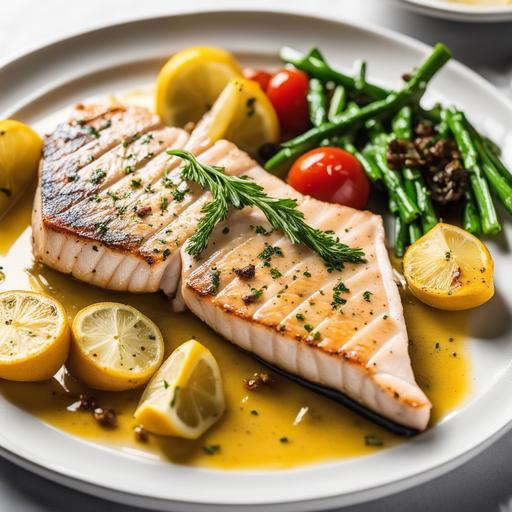
Swordfish Oven Recipe: A Comprehensive Guide
Welcome to our comprehensive guide on preparing a delectable and flavorsome swordfish oven recipe. Swordfish is a popular seafood choice with its firm texture and mild flavor, making it a perfect canvas for various culinary creations. In this article, we will explore the food science behind swordfish, culinary techniques, selection criteria, cleaning and preparation methods, tips for cooking, different variations, doneness checks, and present you with a mouthwatering recipe. So grab your apron, sharpen your knives, and let’s dive into the world of swordfish preparation!
Food Science
Before understanding the culinary details of swordfish, it’s essential to delve briefly into the food science aspect. Swordfish, scientifically known as Xiphias gladius, is a large predatory fish found in both temperate and tropical oceans. Due to its diet primarily consisting of other fish species, swordfish exhibits a high level of fat content. However, don’t let that discourage you, as this fat imparts a creamy and rich flavor to the final dish.
The firm texture of swordfish results from its muscular structure, which provides a satisfying bite and promotes the versatile nature of this fish when cooked. Furthermore, swordfish is an excellent source of lean protein, omega-3 fatty acids, vitamin B12, and selenium, making it a nutritious choice for seafood enthusiasts.
Culinary Details
Selection
Selecting the right swordfish fillet is crucial for achieving the best results. Here are some essential points to consider:
-
Freshness: Opt for freshly caught swordfish whenever possible. Look for clear and bright eyes, a moist and glistening skin, and a firm texture.
-
Odor: The fish should have a mild, fresh, and slightly sweet aroma. If there is any overpowering or fishy smell, it may indicate poor quality or spoilage.
-
Color: The color of swordfish flesh varies from pale beige to a rose or rosy brown shade. Avoid fillets with any discoloration, such as dark spots or fading.
-
Thickness: Go for thicker fillets, as they tend to have a juicier and more tender texture.
Cleaning and Preparation
Once you have acquired a top-quality swordfish fillet, proper cleaning and preparation are key to optimal cooking. Here’s a step-by-step guide to help you prepare the fish:
-
Rinse: Gently rinse the swordfish fillet under cold water to remove any debris or excess blood. Pat it dry using a paper towel.
-
Skin Removal (optional): Unlike some other fish, the skin of swordfish is tough and does not have a pleasant taste or texture. If desired, remove the skin by placing the fillet skin-side down on a cutting board. Use a sharp knife to separate the flesh from the skin, making long, smooth strokes.
-
Pin-Bone Removal: Run your fingers along the flesh to locate any pin-bones, which are thin, small bones that may be present. Use a pair of tweezers or fish pliers to carefully remove them.
-
Portioning: Cut the swordfish fillet into individual serving-sized portions, taking into account the cooking method and personal preference.
Tips for Cooking Swordfish
To ensure a successful and delicious dish, here are some valuable tips for cooking swordfish:
-
Marinade: Marinating the swordfish fillets for at least 30 minutes before cooking can enhance the flavors and tenderize the meat. Popular marinade options include lemon juice, olive oil, herbs, and spices.
-
Seasoning: Be generous with your seasonings, as swordfish can handle robust flavors. Experiment with herbs like rosemary, thyme, or spices such as paprika, coriander, and cayenne.
-
Oil Selection: Opt for an oil with a high smoke point, such as vegetable or avocado oil, to prevent burning during cooking.
-
Preheating the Oven: Always preheat your oven to the desired temperature before placing the fish inside. This helps ensure even and consistent cooking.
-
Resting Time: Allow the cooked swordfish to rest for a few minutes before serving. Resting is essential to retain moisture and redistribute juices throughout the meat.
Variations
The versatility of swordfish allows for various culinary interpretations. Here are a few delicious variations to consider:
-
Grilled Swordfish: Take advantage of your grill by marinating the swordfish fillets and grilling them over medium-high heat. This cooking method creates a tantalizing smoky flavor and distinct char marks.
-
Pan-Seared Swordfish: Heat a skillet with oil over medium-high heat and sear the seasoned swordfish fillets for a few minutes on each side. This method provides a delightful crispy crust while keeping the center tender and juicy.
-
Citrus-Glazed Swordfish: Prepare a zesty citrus glaze using a combination of lemon or orange juice, honey, and soy sauce. Baste the glaze on the swordfish while grilling or baking to infuse it with a delightful tangy taste.
Doneness Checks
Determining when your swordfish is perfectly cooked requires a few simple checks. Here’s what to look out for:
-
Visual Inspection: When cooked, swordfish turns opaque and flakes easily with a fork. The flesh should appear moist and slightly translucent in the center.
-
Internal Temperature: Use a food thermometer to ensure the internal temperature reaches 145°F (63°C) for swordfish to be thoroughly cooked and safe to consume.
-
Texture: Overcooked swordfish becomes dry and loses its desirable texture. Aim for a tender and moist consistency, which melts in your mouth.
Swordfish Oven Recipe

Now that we have explored the food science, culinary details, selection, and tips for cooking swordfish, it’s time to present you with a tantalizing recipe for preparing swordfish in the oven.
Ingredients:
-
1 pound (450g) swordfish fillet
-
2 tablespoons olive oil
-
2 garlic cloves, minced
-
1 tablespoon freshly squeezed lemon juice
-
1 teaspoon dried oregano
-
Salt and pepper to taste
Instructions:
-
Preheat your oven to 400°F (200°C).
-
Rinse the swordfish fillet under cold water and pat dry.
-
In a small bowl, combine the olive oil, minced garlic, lemon juice, dried oregano, salt, and pepper. Mix well to create a flavorful marinade.
-
Place the swordfish fillet in a shallow dish or ziplock bag and pour the marinade over it. Make sure the fillet is evenly coated on all sides. Let it marinate in the refrigerator for at least 30 minutes.
-
Grease a baking dish lightly with oil or use parchment paper to prevent sticking.
-
Remove the swordfish fillet from the marinade, slightly shaking off any excess liquid. Place it in the prepared baking dish.
-
Bake the swordfish in the preheated oven for approximately 12-15 minutes or until the internal temperature reaches 145°F (63°C).
-
Once cooked, remove the swordfish from the oven and let it rest for a few minutes.
-
Serve the perfectly cooked swordfish fillet with your choice of sides, such as roasted vegetables, citrus-infused couscous, or a fresh green salad.
Conclusion
Congratulations! You have now mastered the art of preparing a delectable swordfish oven recipe. This comprehensive guide has covered various aspects, including food science, culinary details, selection, cleaning, preparation, tips for cooking, variations, doneness checks, and provided you with a mouthwatering recipe. Remember to unleash your creativity by experimenting with different flavors and techniques to tailor the recipe to your preferences. Enjoy the flavorsome journey of swordfish preparation and delight your taste buds with this exquisite culinary experience!
Sources
FAQS On Swordfish Oven Recipe
What Temperature Should I Set My Oven To When Cooking Swordfish?
Preheat your oven to 400 degrees Fahrenheit for optimal cooking of swordfish.
How Long Should I Cook Swordfish In The Oven?
The cooking time for swordfish depends on the thickness of the fillets. As a general guideline, cook the fish for about 10 minutes per inch of thickness. However, keep a close eye on the fish to avoid overcooking it. The flesh should be opaque and flake easily when cooked properly.
Do I Need To Marinate Swordfish Before Cooking It In The Oven?
While marinating swordfish can enhance its flavor, it is not necessary. Swordfish has a meaty and slightly sweet taste on its own, so marinating is optional. However, if you prefer to marinate the fish, a simple combination of olive oil, lemon juice, minced garlic, salt, and pepper works well.
Can I Cook Swordfish In Foil Packets In The Oven?
Yes, cooking swordfish in foil packets is a popular method. It helps retain moisture and allows the flavors to meld together. To do this, place the seasoned swordfish fillets on a large sheet of foil, fold the foil over the fish, and tightly seal the edges. Cook the packets in a preheated oven for the recommended cooking time.
How Can I Tell If The Swordfish Is Fully Cooked?
To ensure your swordfish is fully cooked, insert a fork into the thickest part of the fish and gently twist it. If the flesh flakes easily and appears opaque, then it is cooked through. Avoid overcooking the fish, as this can result in a dry and less enjoyable texture. Remember, it is always better to slightly undercook than to overcook swordfish.


